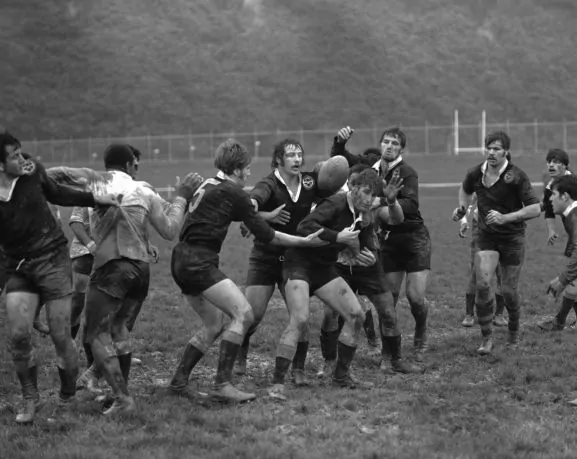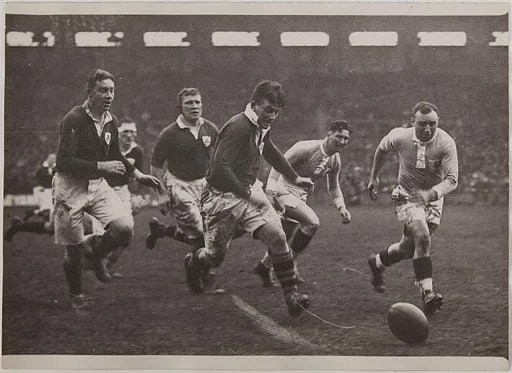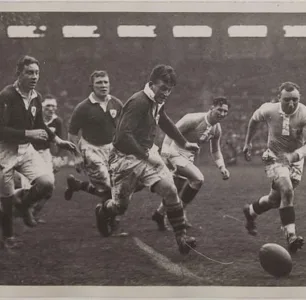Rugby football was invented in the early 19th century at Rugby School in Rugby, Warwickshire, England. The game is said to have originated from a football match where a player, William Webb Ellis, picked up the ball and ran with it, instead of following the traditional rules of soccer. This led to the creation of a new version of the sport that became known as Rugby Football.
Who was William Webb Ellis
William Webb Ellis was a student at Rugby School in Rugby, Warwickshire, England, in the early 19th century. He is credited with originating the game of rugby football. According to legend, during a soccer match at Rugby School in 1823, William picked up the ball and ran with it, breaking the existing rules of the game. This spontaneous act is said to have inspired the creation of the sport of Rugby Football. However, the veracity of this story is disputed and there is little concrete evidence to support it.

Regardless, William Webb Ellis is remembered as the person who is said to have invented the sport of Rugby.
How is rugby different from football
Rugby and football (also known as soccer) are two different sports that evolved from a common ancestor. Here are some key differences between the two:
- Method of ball progression: In rugby, the ball can be carried, passed, or kicked forward, while in football, only kicking is allowed as a means of advancing the ball.
- Scoring: In rugby, a try is scored by touching the ball down in the opponent’s end zone, and it’s worth 5 points. A conversion kick is worth 2 points, while penalty kicks and drop goals are worth 3 points each. In football, a goal is scored by getting the ball into the opponent’s net and it’s worth 1 point.
- Tackling: Tackling is a key aspect of rugby, with players allowed to tackle opponents carrying the ball. In football, tackling is limited to attempting to take the ball away from an opponent, and sliding tackles are not allowed.
- Number of players: Rugby is played with 15 players on each team, while football is played with 11 players on each team.
- Shape of the ball: Rugby balls are oval-shaped, while footballs are spherical.

These are just a few of the differences between rugby and football, and each sport has its own unique rules and strategies that set it apart from the other.
Why is a rugby ball oval
A rugby ball is oval-shaped because it allows players to handle the ball more easily and makes it easier to pass and carry. The oval shape also makes it more difficult for the ball to slip out of a player’s hand, which is important in a sport where ball-handling is crucial. The shape of the ball is thought to have evolved over time, with early versions of the sport being played with round or cylindrical balls.

However, it was found that an oval ball was easier to carry and handle, and it soon became the standard shape for rugby balls. The design of the rugby ball has changed very little over the years, with the oval shape being seen as an essential part of the sport’s identity.
Whats the difference between rugby league and rugby Union
Rugby League and Rugby Union are two distinct versions of the sport of rugby that originated in England in the late 19th century. Here are some key differences between the two:
- Number of players: Rugby League is played with 13 players on each team, while Rugby Union is played with 15 players on each team.
- Tackle rules: In Rugby League, a tackled player must release the ball immediately after being tackled, while in Rugby Union, a tackled player can retain possession of the ball by rolling or crawling with it.
- Scrum rules: In Rugby League, scrums consist of only three players from each team, while in Rugby Union, scrums consist of eight players from each team.
- Play-the-ball rule: In Rugby League, a tackled player must play the ball by rolling it between their legs with their foot, while in Rugby Union, there is no such requirement.
- Tackle count: In Rugby League, there is a six-tackle rule, after which the attacking team must surrender possession, while in Rugby Union, there is no set limit on the number of tackles.
- Point system: In Rugby League, tries are worth 4 points, while goals (kicks between the posts) are worth 2 points. In Rugby Union, tries are worth 5 points, conversions are worth 2 points, and penalties and drop goals are worth 3 points.
These are some of the main differences between Rugby League and Rugby Union, and each sport has its own unique rules and strategies that set it apart from the other.
Why play rugby
People play rugby for a variety of reasons, including:
- Physical challenge: Rugby is a physically demanding sport that requires strength, speed, endurance, and coordination. It provides a great workout and can help players improve their fitness levels.
- Teamwork: Rugby is a team sport that requires players to work together to achieve a common goal. This can help build camaraderie, teamwork skills, and leadership skills.
- Competitive spirit: Rugby is a competitive sport that offers players the opportunity to test their skills against other players. The fast-paced and physical nature of the game can be very exciting and challenging, and players can experience a sense of achievement and satisfaction when they perform well.
- Social benefits: Rugby is a social sport that provides players with opportunities to meet new people, make friends, and be part of a team. It can also be a great way to spend time with friends and family.
- Tradition and heritage: Rugby has a rich history and tradition, and many players are drawn to the sport because of its roots and cultural significance.
These are just a few of the reasons why people play rugby, and each player may have their own unique motivations for participating in the sport. Regardless of the reason, rugby can be a fun, challenging, and rewarding experience for anyone who loves to play.

